Learn how to make agar agar jelly with this super easy recipe. This is a basic jelly recipe, made using agar agar powder. The jelly requires only 3 basic ingredients - agar agar powder (key ingredient), sugar and water. With only 15 minutes preparation time, this easy agar agar recipe is super quick to make and when served chilled, makes an absolutely refreshing treat on a hot summer day.

The best part about this agar agar recipe is that you can use it to make agar agar jelly in any flavor you like. For more agar agar flavors, check out this coconut jelly, pandan jelly, mango jelly and fruit jelly cake.
For more types of jelly, you can try this aiyu jelly made using aiyu jelly powder and these lychee jelly and nata de coco jelly made using konnyaku jelly powder. They are equally easy to make!
Jump to:
- ❤️Why You Will Love This Recipe
- What is Agar Agar Powder and What Is It Made Of?
- How to Use Agar Agar Powder?
- How to Use Agar Agar Strips or Agar Agar Flakes?
- Agar Agar vs Jelly vs Gelatin vs Konnyaku
- 📋Ingredients
- 🧾Substitution and Variations
- 👩🍳How to Make
- 💡Expert Tips
- 💭FAQs
- ❤️More Recipes You Will Love
- 📖Recipe
❤️Why You Will Love This Recipe
- It is very quick and easy to make, you only need 3 basic ingredients and 15 minutes preparation.
- You can use this basic recipe to make agar agar jelly in any flavor you like.
- It makes a light and refreshing dessert.
What is Agar Agar Powder and What Is It Made Of?
Agar agar powder is a plant based jelly powder made from seaweed (red algae). Agar agar is a common dessert in Asia and has different names in different countries. According to Wikipedia, agar agar is said to have derived its name from a Malay word agar which means algae. Is it also referred to as kanten jelly, China grass, Japanese Isinglass, Ceylon Moss or Jaffna Moss (source: Wikipedia).
Agar agar is often used to make jellies and as a substitute for animal gelatin. You can find it in powder form or in long thin strips or flakes. You can find it in Asian supermarkets or wholefood markets and online food stores. It works in the same way as gelatin or konnyaku jelly.
How to Use Agar Agar Powder?
When using agar-agar powder to make jelly, it is advisable to mix it with sugar first before adding into water. This helps avoid the jelly powder from clumping.
The water has to be at room temperature. You then stir the sugar and agar agar powder for about 1 minute in the water before heating it and bringing it to a boil. To this you add any coloring or concentrated flavoring as you wish.
How to Use Agar Agar Strips or Agar Agar Flakes?
To make agar agar jelly using agar agar strips, you need to soak them in water for about 20 to 30 minutes to soften them.
And then you add them into a pot of water and cook them until they dissolve. You then add sugar to the agar agar solution and any coloring or flavoring you wish. Agar agar strips take a longer time to cook compared to agar agar powder.
Agar Agar vs Jelly vs Gelatin vs Konnyaku
Agar agar is a plant based jelly, suitable for vegans and vegetarians. It is also commonly used as a vegetarian or vegan substitute for gelatin in desserts. Agar agar is often sold in powder form and in long thin strips. In powder form, it has a fine texture and is slightly yellowish in color. In strips, it is colorless. On its own, agar agar is tasteless. In terms of texture, agar agar is firmer than gelatin but not as firm as konnyaku. It is also less chewy compared to konnyaku jelly.
Jelly is a term used for sweet desserts made using agar agar, gelatin or konnyaku and therefore is a term used with agar agar, gelatin and konnyaku. Jelly is also used to describe fruit jam/preserves.
Gelatin is derived from animals (most often cows) and can be found in powder and in thin sheet form. In powder form, it is yellowish in color and has a coarse, brown sugar-like texture. In sheet form, the color ranges between clear and colorless to light yellow. Similar to agar agar, on its own, gelatin is tasteless. Once heated, it gels up, but the texture is not as firm as agar agar or konnyaku jellies. Gelatin is often used in unbaked cheesecakes and treats like fruit gummies, marshmallow, fondant, and panna cotta.
Konnyaku, similar to agar agar, is a plant based jelly. It is derived from a plant called Konjac or Devil's Tongue yam. Konnyaku is often found in fine powder form and is white in color. Similar to both agar agar and gelatin, on its own, the konnyaku jelly is tasteless. It is often used to make jelly and has a firmer texture compared to agar agar and gelatin. One of konnyaku jelly's main differences is its chewy texture.
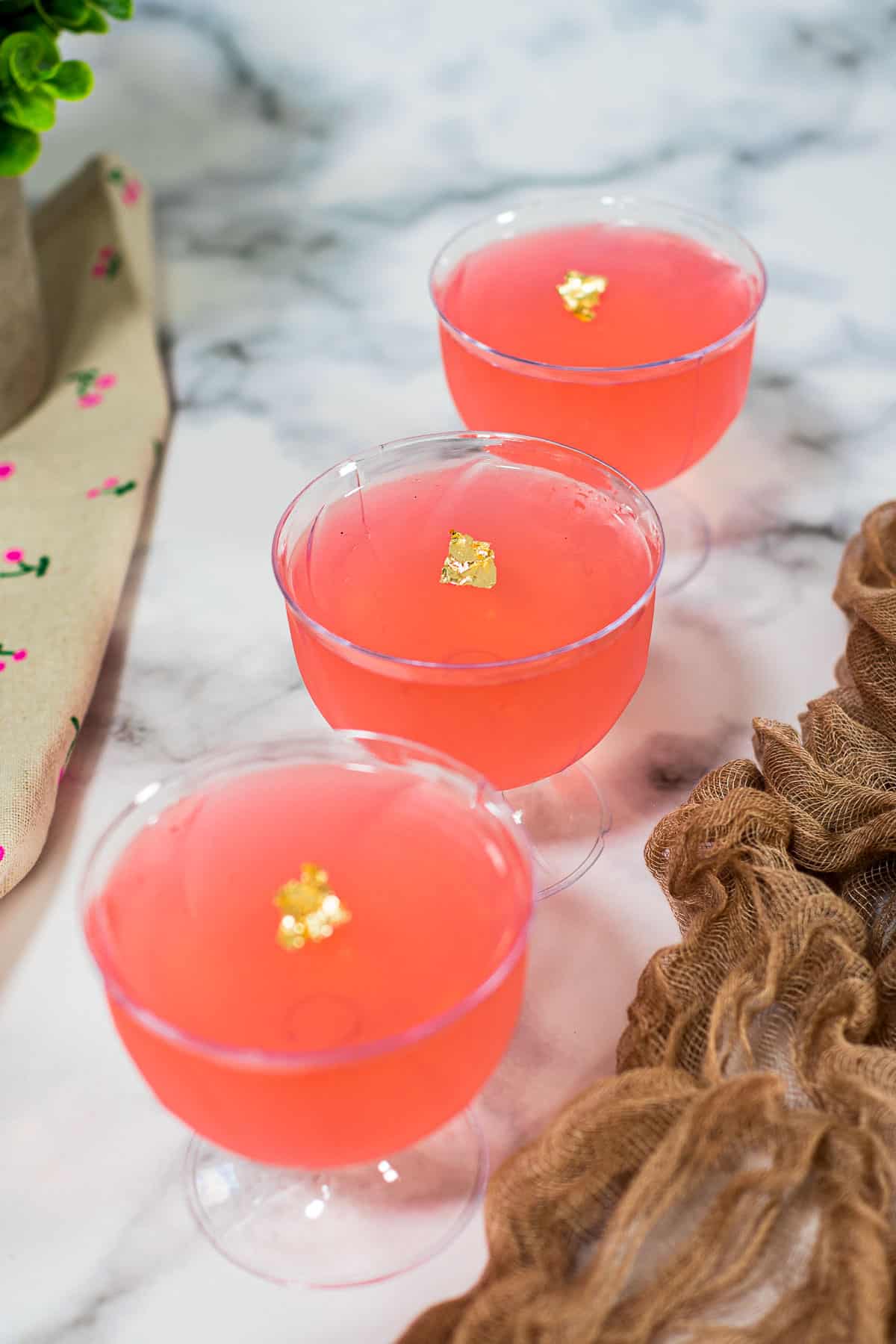
📋Ingredients

- Agar agar powder - the powder is often sold in small packets of 10g. Some are flavored, colored and sometimes sweetened. Choose unflavored, colorless and unsweetened powder for this recipe.
- Granulated sugar - dissolves quicker than coarse sugar, however, coarse sugar can also be used.
- Water - to cook the agar agar. Use filtered water.
- Rose extract (optional) - this is used for flavoring. It is clear that therefore does not change the color of the jelly.
- Pink food coloring (optional) - used in very small quantity to color the jelly. Both gel based food coloring or liquid food coloring with work.
- Edible gold flakes (optional) this is for decoration.
*Refer to the recipe card below for full list of ingredients and exact quantities. For best results, use a digital kitchen scale where applicable*
🧾Substitution and Variations
- Agar agar powder can be substituted with konnyaku jelly powder. Replace it by the exact same amount.
- You can also make agar agar in distinct layers by combining 2 or more flavors. A simple combination would be coconut and fruits such as ripe mangoes. You can make coconut layer agar agar as the first layer and have the mango jelly as the top layer, vice versa. Make the jelly solution in 2 batches. For the first batch, replace half of the water with coconut milk and the second batch, replace half with mango puree. For added flavor, you can even include cut fresh mango cubes in the mango layer.
- Another great flavor option for agar agar is pandan. Instead of using the rose extract, cut up one or two pandan leaves and add it to the jelly solution as you boil it. Discard the leaves before pouring the cooked jelly into molds. You can add some food coloring to your pandan jelly or leave it as a clear layer of jelly with pandan flavor.
- Agar agar is great when served with fruits. You can add cut fruits into your agar agar or substitute some of the liquid measurement in the recipe with fruit juice like in this fruit jelly cups or fruit jelly cake.
- For a sugar free option, you can make agar agar jelly with coconut water. Simply replace the water in the recipe with coconut water and omit the sugar. Pour the cooked jelly into molds and serve once the jelly sets.
- Coconut milk agar agar is another great flavor option. Check out my coconut agar agar here, made using thick coconut milk.
This recipe has not been tested with other substitutions or variations. If you do try, please let me know in the comments section below!
👩🍳How to Make
Step 1: Prepare the molds. Wash and pat them dry and set aside while you cook the jelly.
This agar agar can be poured into individual serving cups. Alternatively, it can also be poured into a single larger mold and cut into agar agar bars or squares and served on serving plates.
Note: The first step in making jellies is to prepare the molds. This is because the jelly sets rather quickly as it cools down and you risk the jelly setting while preparing the molds if you do it after cooking the jelly.

Step 2: Cook the jelly. Measure the jelly powder into granulated sugar. Stir to mix until the agar agar powder and the sugar until well mixed (image 1).
Note: This step helps in avoiding the powder from clumping when added into the water.
Next, measure water into a medium sized pot. Add the jelly-sugar mixture into the water and stir for about 30 seconds to 1 minute to disperse the sugar and jelly (image 2).
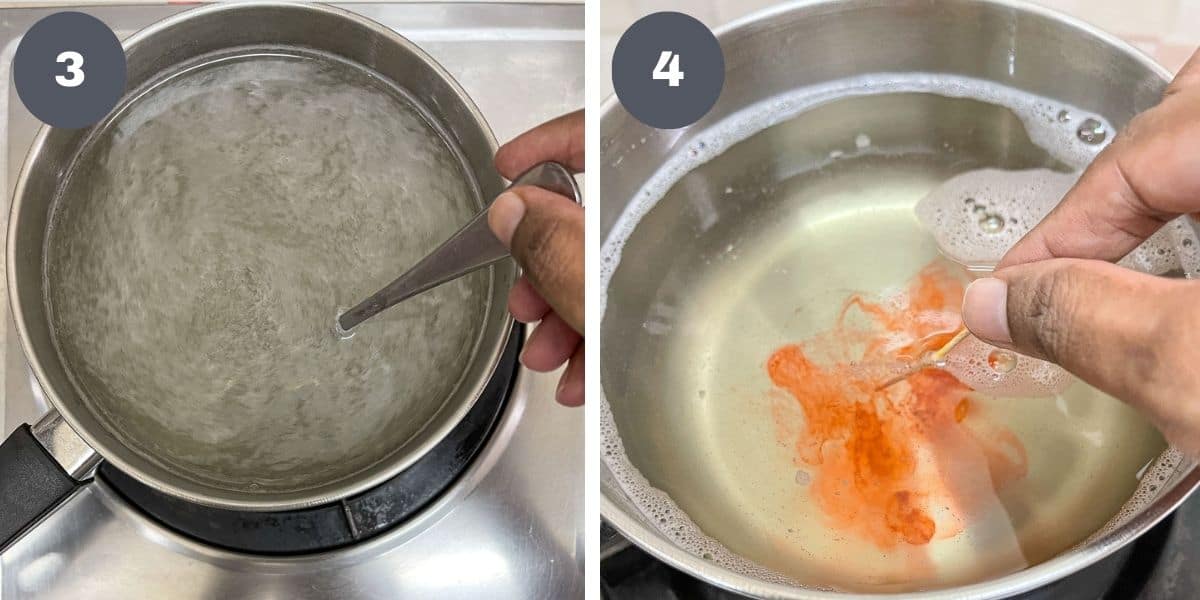
Place the pot on low heat and cook the jelly until it starts to boil. Remember to keep the heat low as you would want the jelly powder to dissolve completely. This should take about 5 to 8 minutes on low heat. Stir constantly (image 3).
Once the jelly reaches a rolling boil point, turn off the heat. Add the rose extract. Follow by the food coloring. You only need to use a small amount of coloring. Mix well (image 4).
Step 3: Pour into molds and allow to set. Pour the jelly solution into the prepared molds.
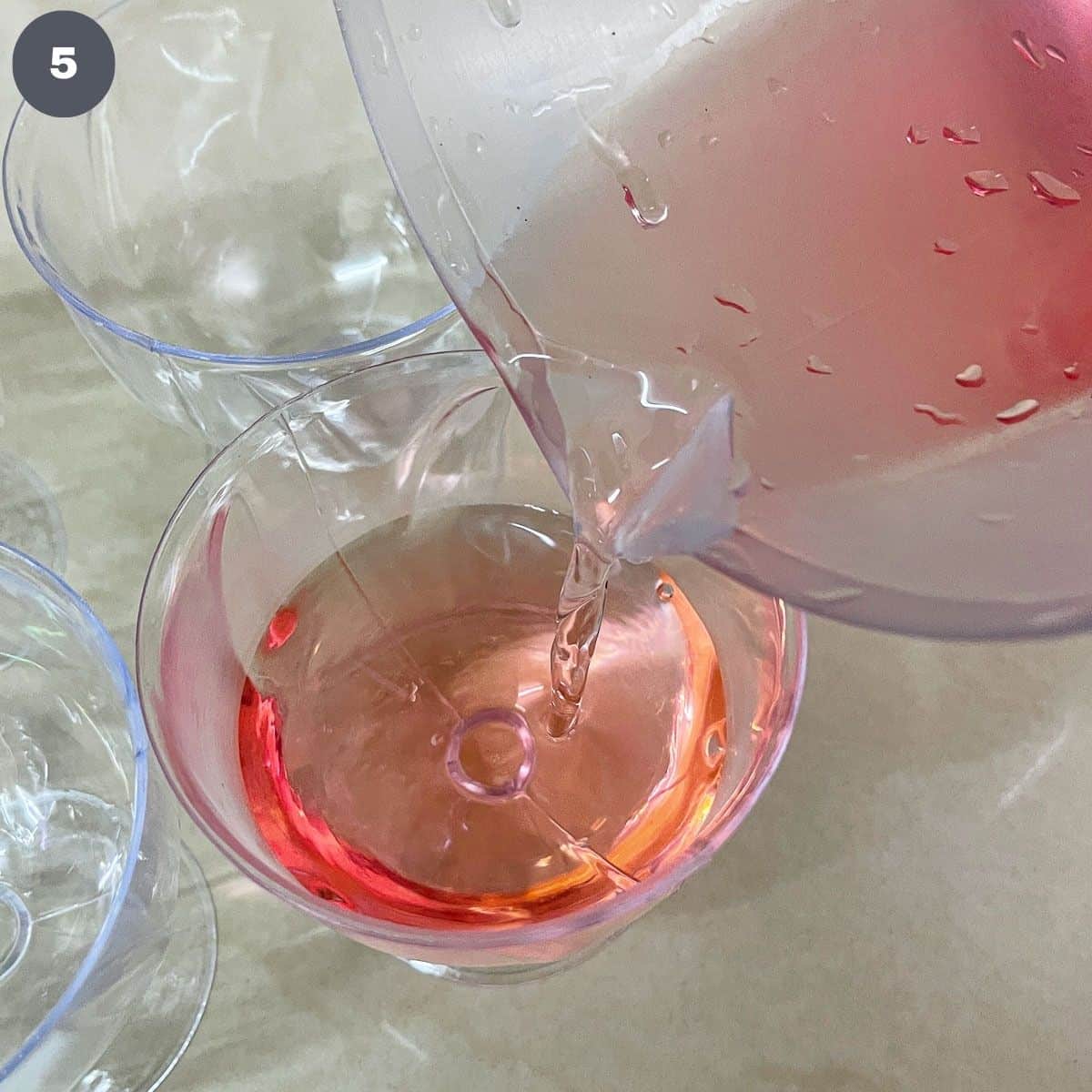
Let them cool down slightly before transferring them to the fridge to set completely for about one to 2 hours (image 5).
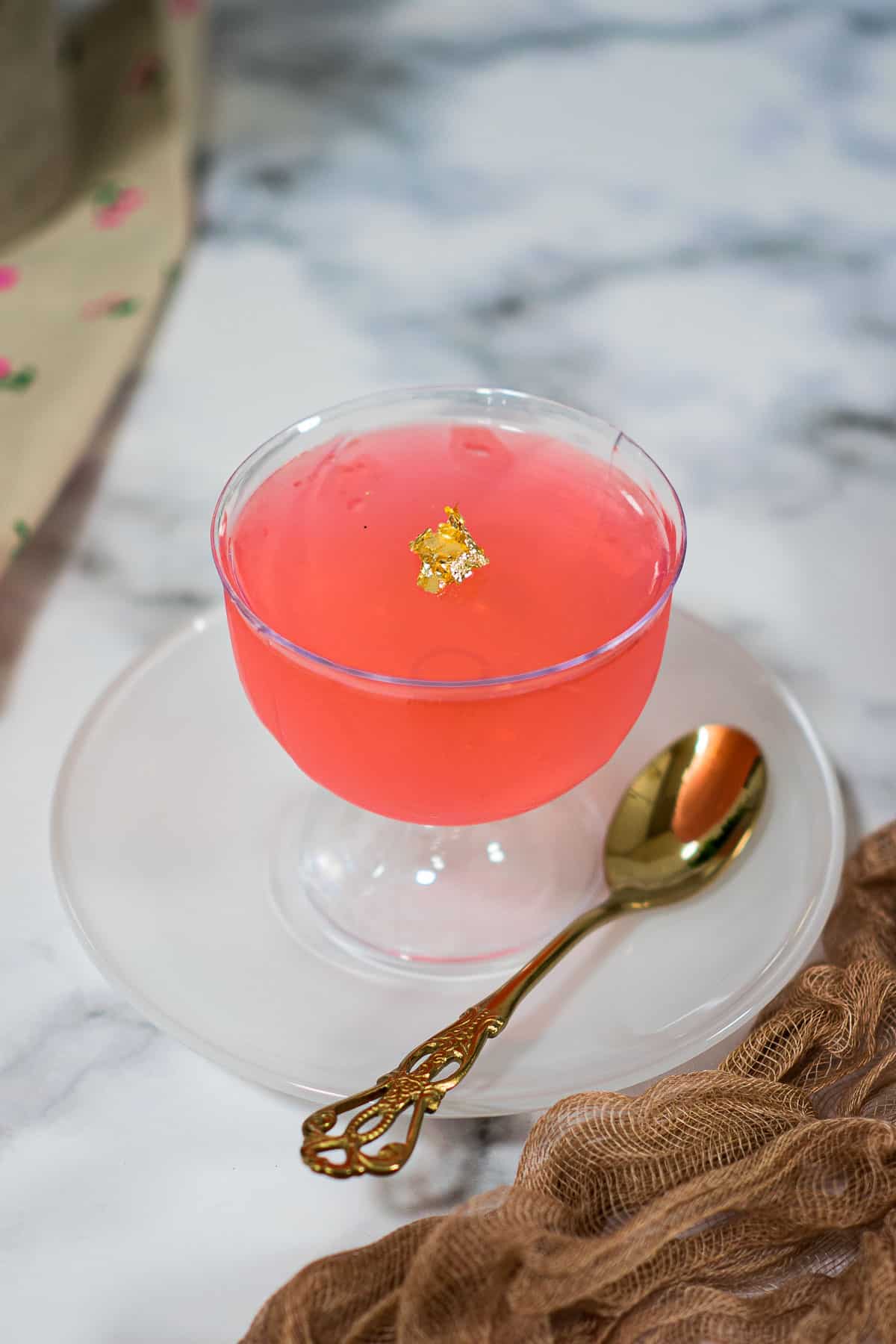
💡Expert Tips
- The time taken for the jelly to set depends on the size of the mold you use. If you pour into a wide and shallow mold, the jelly will set much quicker compared to small and deep molds. Chilling the jelly will also help to set it quicker.
- To test if the jelly is ready, shake the mold very gently. If you see the agar agar wobbly and shaking, it is not set. If it does not move, try to press lightly with your finger. The jelly is ready if it is firm to the touch.
- The key point to note in making agar agar jelly is the ratio of the jelly powder to the water/liquid. For every 10g of agar agar powder, use between 950ml to 1 liter of water. This water ratio yields firm and perfectly textured agar agar jelly.
- If you wish to add any fruit juices to make your agar agar, make sure to keep the total liquid measurement between 950ml to 1 liter. For example, if you wish to make an orange agar agar and wish to use fresh orange juice to flavor your jelly, you can replace the water in the recipe with orange juice. If you are using concentrated juice, make sure you reduce the water in the recipe by the amount of the concentrated juice you use. In my mango jelly recipe here, I used pureed fresh mangoes to make the mango agar agar. To keep the water ratio in the jelly intact, I reduced the water used in making the jelly by the amount of mango puree I added to the jelly.
- If you wish to add additional solid ingredients to your agar agar such as cut fruits, you need not adjust the ratio of water and agar agar powder used. Simply add these fruits into your cooked jelly and let it set before consuming.
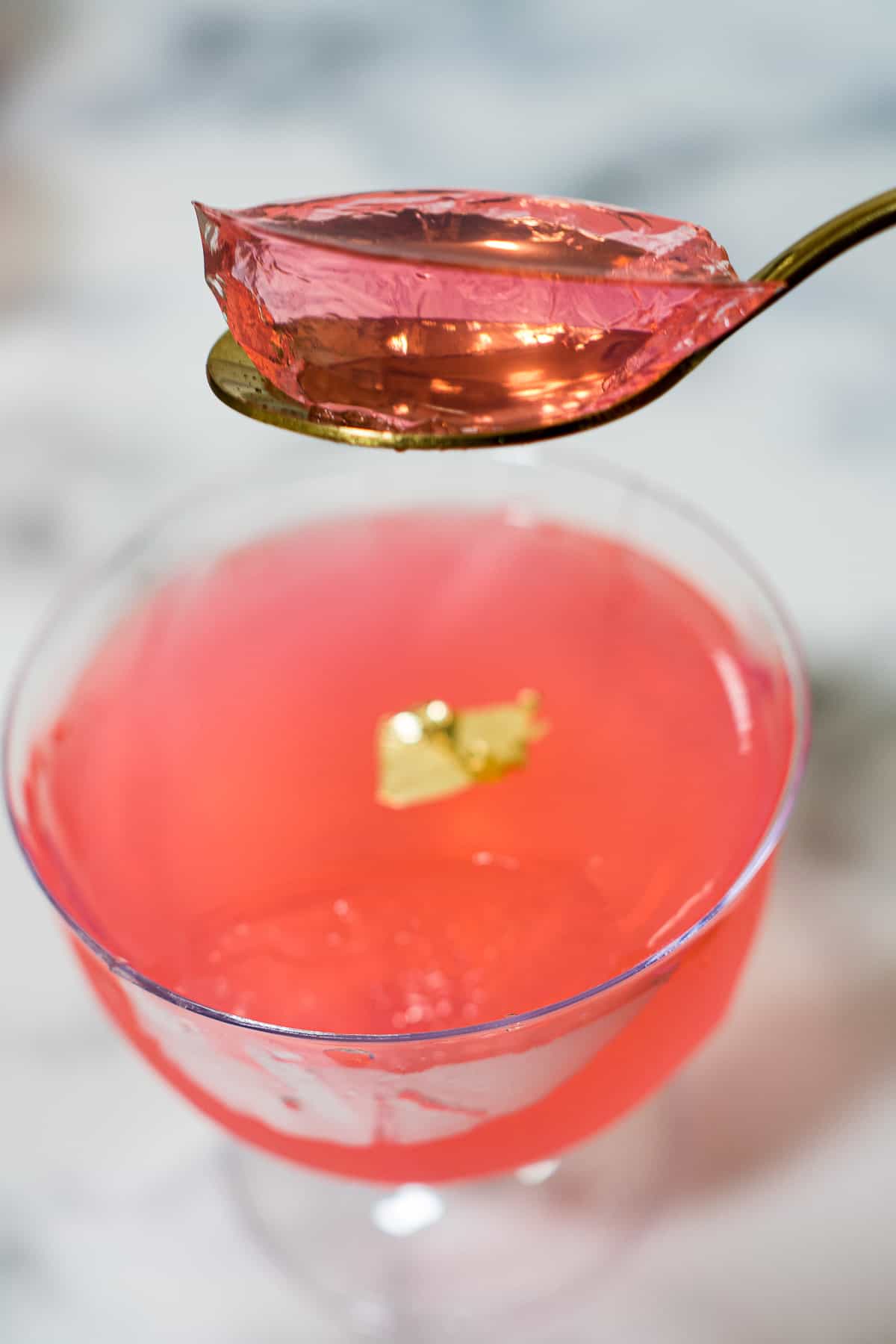
💭FAQs
Yes, it is. Agar agar is a plant based jelly derived from seaweed and is therefore perfect for vegetarians and vegans.
The most common reason for agar agar to remain liquid and not solidify properly is due to higher ratio of water to the agar agar powder.
To avoid this problem, keep to the amount of liquid mentioned in the recipe. If you wish to add additional liquid ingredients (such as juices for flavoring), remember to reduce the water in your recipe by the amount of additional liquid ingredients in the recipe. That way, you jelly will set well.
Other reasons could be undercooking the jelly solution and insufficient time to set. If the jelly powder is not fully dissolved, the jelly will not set properly. Make sure to cook the jelly to a rolling boil point.
And depending on the mold used to set the jelly, the time taken might differ. It will be quicker for wide and shallow mold and longer for deep molds. Always check by shaking the mold or pressing lightly with your finger. If it is no longer wobbly and is firm to the touch, it is ready.
Keep the jelly chilled until ready to serve. Also keep any leftovers in the refrigerator. This jelly can last in the fridge for a good 4 to 5 days.
❤️More Recipes You Will Love
Do you like this recipe? Please leave a 5-star ⭐⭐⭐⭐⭐rating in the recipe card below and consider a review further down this page. I would love to hear from you. Thank you!
📖Recipe

Agar Agar Jelly
For best results, use the metrics measurements. US customary measurements have not been tested and are only meant for guide.
Ingredients
- 10 g agar agar
- 1 liter water
- 200 g granulated sugar
Optional
- ½ teaspoon rose extract
- A few drops of pink food coloring
- Gold flakes (edible)
Instructions
- Wash and pat the molds dry. Set them aside while making the jelly (see Note 1).
- Measure sugar into a bowl. Add the agar agar powder and mix well (see Note 2).
- Pour water into a medium sized pot. Add the agar agar and sugar mixture into the water and stir well for about 30 seconds.
- Heat up the jelly solution over low flame. Stir constantly.
- Let the jelly cook over the low heat until it reaches a rolling boil point. Make sure to stir it constantly.
- As soon as the jelly starts boiling, turn off the heat.
- Let the jelly cool for a few minutes before adding the rose extract and the pink food coloring. Stir well to disperse the color evenly in the agar agar.
- Pour the agar agar into the prepared molds.
- Let them rest at room temperature for about 15 minutes before transferring to the refrigerator to set completely.
- To test if the jelly is set, shake the molds gently. If the jelly is wobbly, it needs more time. If it does not move, try pressing lightly with your finger. If it is firm to the touch, it is ready to serve. Decorate the top with gold flakes if you wish.
- Keep the jelly chilled until it is ready to be served. The jelly is best served chilled.
Notes
- The first step in making jellies is to prepare the molds. This is because the jelly sets rather quickly as it cools down and you risk the jelly setting while preparing the molds if you do it after cooking the jelly.
- This step helps in avoiding the powder from clumping when added into the water.
- The time taken for the jelly to set depends on the size of the mold you use. If you pour into a wide and shallow mold, the jelly will set much quicker compared to small and deep molds. Chilling the jelly will also help to set it quicker.
- The key point to note in making agar agar jelly is the ratio of the jelly powder to the water/liquid. For every 10g of agar agar powder, use between 950ml to 1 liter of water. This water ratio yields firm and perfectly textured agar agar jelly.







Leave a Reply